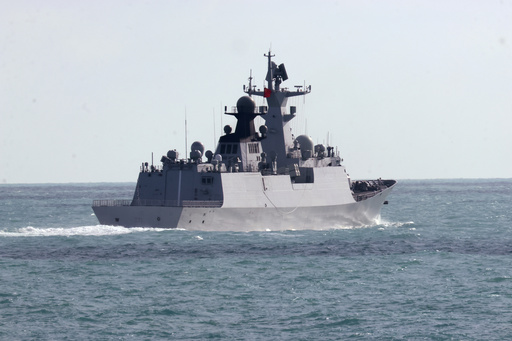Leaders from both Australia and New Zealand have expressed concern regarding China’s navy, which conducted unexpected live-fire drills in international waters situated between the two nations. This military exercise, which took place over the Tasman Sea, has caused several commercial flights to be rerouted on very short notice.
The naval drills, involving three Chinese warships, were carried out on Friday and Saturday in waters that are heavily trafficked by commercial flights. At least one instance of live fire was reported during these operations. Although there were no allegations of legal violations by China, the incident is seen as a reflection of rising tensions in the region driven by China’s expanding influence.
Spanning approximately 1,200 miles (2,000 km) between Australia and New Zealand, the Tasman Sea is a critical area for both countries, which are considered major Western players in the South Pacific. The Australian government indicated that these warships were operating unusually close to their territorial waters on an undeclared mission, which was characterized as “not unprecedented, but unusual” by Australian Defense Minister Richard Marles.
Problems arose when commercial flights were quickly diverted following communications from the Chinese vessels, alerting pilots to the live-fire exercise occurring below them. While there has been no confirmation of live fire during the initial drills, a New Zealand naval ship did observe firing from the warships during surveillance operations on Saturday.
Despite affirming that China acted within legal boundaries, political figures in both Australia and New Zealand underscored the need for advance notice regarding such exercises. This was particularly concerning as the drills occurred much further south than anticipated. New Zealand’s Defense Minister Judith Collins relayed that the notice given for these live-fire actions was only a couple of hours rather than the usual 12 to 24 hours. Although there is no legal obligation for such notifications, Collins stated that her government was seeking clarifications from the Chinese embassy regarding future military activities.
Additionally, leaders from both nations assured that there was no immediate threat stemming from the operations; however, they stopped short of criticizing China. It’s important to note that China is a major trade partner for both nations, and the situation follows a recent period of improved relations between Beijing and Australia, following the easing of a lengthy trade freeze on various Australian products.
These recent developments may compel the Australian government to reconsider its previously optimistic stance toward its relationship with China. Michael Shoebridge, a former official in defense and security, noted that recognition of ongoing threats from China could significantly undermine the government’s foreign policy achievements concerning China.
In response to the allegations, Chinese officials firmly denied claims that their military failed to provide adequate warnings about the drills. Wu Qian, a spokesperson for China’s Defense Ministry, asserted that the navy provided multiple safety notifications prior to the exercises and accused Australian leaders of making unreasonable claims against China.
Analysts speculate that China’s frustration with Australia’s increasing military alliances in Asia may be a contributing factor to the drills. Strengthened defense partnerships with nations such as Japan, the Philippines, and Vietnam, all of which have territorial disputes with China, could have prompted these actions. Given the shifting dynamics in global relations, this could lead to increased tensions in the region.
Moreover, China is actively seeking security agreements with smaller island nations in the South Pacific, which has raised alarms in both Wellington and Canberra regarding potential territorial disputes close to home. Regional leaders have expressed their discontent over the close examination of their diplomatic relations by Australia and New Zealand.
Shoebridge summarized the situation, remarking that there are indeed complexities involved with developing military ties with China, and that the implications of such relationships are becoming more apparent. He expressed deep concern that the military tensions associated with China in Southeast Asia could potentially overflow into the South Pacific region.


